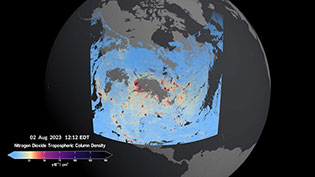Science
TEMPO's scientific goals are focused on providing data for answering key questions related to atmospheric composition and air quality. The mission's science questions flow from the NASA 2010 Science Plan and the 2007 National Research Council (NRC) Decadal Survey recommendations for Earth Science and Applications from Space. In response to these priorities, TEMPO was designed to make measurements of atmospheric composition, improve the ability to forecast air quality, and create a dataset for examining the societal impacts of air quality.
TEMPO's science questions are drawn in large part from the atmospheric chemistry work done by the GEO-CAPE Atmospheric and Oceanic Science Working Groups formed in response to the 2007 NRC Decadal Survey. TEMPO science team members have many years of experience with requirements developed by the air quality community, using atmospheric observations from instruments on polar-orbiting satellites in low Earth orbit, including OMI, OMPS, SCIAMACHY and GOME. TEMPO measures many of the same atmospheric constituents as these heritage instruments, but its geostationary orbit enables groundbreaking spatial and temporal resolutions.
TEMPO's advanced capabilities can help answer questions such as:
- What are the temporal and spatial variations of emissions of gases and aerosols important for air quality?
- How do physical, chemical, and dynamical processes determine tropospheric composition and air quality over spatial scales ranging from urban to continental, and temporally from diurnal to seasonal?
- How can observations from space improve air quality forecasts and assessments for societal benefit?
- How do episodic events (e.g., wildfires, dust outbreaks, and volcanic eruptions) affect atmospheric composition and air quality?
To help address these questions, TEMPO measures key gases and aerosols involved in air quality and atmospheric composition, and their transport. These measurements include tropospheric and total ozone, nitrogen dioxide, formaldehyde, cloud cover and height, and aerosol optical depth, type and layer height. When located at the surface, ozone is detrimental to human health and damages vegetation, which can lead to lower crop yields. High levels of fine aerosols (particulate matter) are associated with adverse health impacts. Nitrogen dioxide and formaldehyde (a proxy for volatile organic compounds) directly impact health, and are precursors to tropospheric ozone and secondary aerosol formation.
